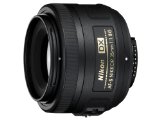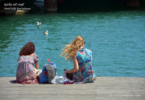Travel Gadget – Nikkor AFS 35mm F1.8 Prime Lense
The most difficult scenes to capture with a digital camera is always night scenes with portraits. Because you can’t ask the people you shoot to freeze for 10 seconds for your camera on tripod. Image is captured by the image sensor of a camera or the film in older era, by emitting lights or reflecting lights onto the sensor (or film), As an analogue device, image sensor is made up by millions of pixels of protons to absorb these lights and generate digital signals data to the brain of a camera, or the image proccessor.
That’s why the ambient lighting is the most important factor in capturing a beautiful scenes. The more light received by the sensor, the brighter or more colourful is the image. Otherwise, the less light is received by the sensor, the darker would be the image. This is when the camera needs to crank up (artificially by electronically amplifying) the sensitivity of the image sensor (which is different in film where different chemical was applied to get higher sensitivity) to be able to read or differentiate the objects. This is called ISO setting of digital camera. ISO 100 is the original sensor sensitivity. whatever higher figure like 200, 400, 800, 1600 or 3200 are all reference number of the amount of sensor amplification. Since there are artificial, image noise will be created. Noise of ISO 800 is definitely more than ISO200, and so on…
 Off course, ISO setting required is also depends on the permeability of lights allowed through the camera lense, the fundamental element of a camera. The permeability of lense is again depends on its opening diameter which is called as F-number or aperture value. The smaller F-number or larger diameter or aperture means more lights would be allowed to go through the lense. Then more lights would be drop onto the sensor. So theoretically, lense should have its maximum diameter opened for light. However, in actual fact, it is easier to say than do…
Off course, ISO setting required is also depends on the permeability of lights allowed through the camera lense, the fundamental element of a camera. The permeability of lense is again depends on its opening diameter which is called as F-number or aperture value. The smaller F-number or larger diameter or aperture means more lights would be allowed to go through the lense. Then more lights would be drop onto the sensor. So theoretically, lense should have its maximum diameter opened for light. However, in actual fact, it is easier to say than do…
When the opening of a lense is larger, it is more difficult for a lense construction to control the light emittance so as to have all lights to be focused onto the sensor. There is a technological limiting factor of doing so. Which is why, as rules of thumb, DSLR lense with a larger maximum aperture is always more expensive because it is really not easy to construct a lense with a large aperture while still able to focus sharp on the sensor. I’m not touching the design of lense construction here though which I’m no expert either. What I’m trying to emphasize here is, in order to shoot nice night portrait, investing on a larger aperture lense is a must!
Off course, you can argue that the size of the image sensor is another factor. Yes, the bigger the sensor is, the larger would be the pixels and more lights would be easily absorbed. This is also why a DSLR caould always shoot better night scenes than a compact camera because their sensor size is in a ratio of 1:4! Again, full frame sized sensor employed in those high end pro DSLR like Canon 5D or Nikon D3 is even better than cropped size sensor in Canon 500D or Nikon D90. Bigger sensor can handle high ISO better. But who normally can afford those cameras? They are just too expensive, bulky and heavy to carry along on budget travel that I’m keen on.
So, unless you could afford RM12k on full frame camera like Canon 5D or Nikon D700 for your travel (I would not do so…), investing on a large aperture lense for DSLR is a better bet for shooting great night scene portrait. 🙂 The answer to it is the budget Nikkor 35mm f/1.8G AF-S DX Lens for Nikon Digital SLR Cameras.
Its F1.8 maximum aperture is 5-stops faster than the standard zoom lense of F5.6 which means your camera shutter speed can shut 5 times faster but still allowing the same amount of light gone through. That is how a night scene portrait can be captured perfectly.
UPDATED Here are some sample image that I captured using the superb Nikkor 35mm f1.8 fast lense on my Nikon D60 hand held to show you its capability of capturing low light images and its sharpness…
McDonald’s in a petrol station snapshot. Captured inside my car while waiting in front of traffic lights.

Inside Pavilion shopping mall. Indoor shot with superb sharpness.

Outdoor pub exterior. Balanced exposure but with evidence of “purple fringing” or chronomatic aberration at high contrast edge.

Ability to create shallow depth of field to the photo.

As long as there is light, 35mm f1.8 nikkor lense can always capture it with ease.

Another hand held shot to the KL night scene. Useful for travel photography though sometimes need to crank up to ISO1600.

Indoor portrait shot with nature indoor daylight. Fast action of children needs fast lense like the f1.8 35mm Nikkor to capture!
Now I can have more photo collection of my children with natural ambient lighting. I just don’t fancy about flash lighting.
From those photos above that I took using only the Nikkor 35mm f1.8 fixed lense which includes night scenes, portraits and close up’s, I would say any traveler carrying a Nikon DSLR camera should have this lense fixed on, all the time, everywhere. – Travel Feeder.










You have this lense? I’m thinking of getting the 50mm f1.8 lense. Cannot afford 50mm f1.4. LOL
- September 11, 2009Yes, you bet Che-Cheh! I bought it because 35mm for DX camera is equivalent to 50mm for FX camera. I’ve tried 50mm f1.8 before… angle of view is slightly narrower than 35mm which makes composition a bit more difficult. So I bought 35mm 🙂
- September 11, 2009>Mei Teng,
- September 11, 2009I bought it for RM800. What about Canon 50mm f1.8?
Yes. Larger aperture means more expensive. Just like Nikon, 50mm f1.8 selling for RM400 while 50mm f1.4 selling for RM1000, not to mention 50mm f1.4 AFS with built in motor which costs over RM2,000!!
>Adrian,
- September 24, 2009If you like the performance of your 50mm f1.8, sure you will love this latest 35mm f1.8 for your D40 🙂
I have been using only this lense lately to shoot everything I found interesting on my recent travel and the only thing that I miss is the 18mm wide angle shot to landscape and that is it! Cheers!
Looks quality shots. How much can I buy such a thing?
- January 4, 2010.-= Turkey´s last blog ..Amasya =-.
hi guys and hi cecil, i own a nikon d50 and d60, may i ask which do you recommend on a prime lens? a 55-f1.8 or a 35-f1.8? are the prices close enough? will it be hard for me to focus since as i review autofocus is not for the 55-f1.8, pls help
- November 23, 2010